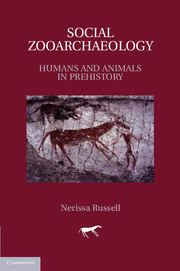Book contents
- Frontmatter
- Contents
- List of tables
- Preface
- 1 Beyond protein and calories
- 2 Animal symbols
- 3 Animals in ritual
- 4 Hunting and humanity
- 5 Extinctions
- 6 Domestication as a human–animal relationship
- 7 Pets and other human–animal relationships
- 8 Animal wealth
- 9 Meat beyond diet
- 10 Studying human–animal relations
- References
- Index
6 - Domestication as a human–animal relationship
Published online by Cambridge University Press: 05 June 2012
- Frontmatter
- Contents
- List of tables
- Preface
- 1 Beyond protein and calories
- 2 Animal symbols
- 3 Animals in ritual
- 4 Hunting and humanity
- 5 Extinctions
- 6 Domestication as a human–animal relationship
- 7 Pets and other human–animal relationships
- 8 Animal wealth
- 9 Meat beyond diet
- 10 Studying human–animal relations
- References
- Index
Summary
Just as humans have a history of their relations with animals, so also animals have a history of their relations with humans. Only humans, however, construct narratives of this history. Such narratives range from what we might regard as myths of totemic origin to supposedly “scientific” accounts of the origins of domestication. And however we might choose to distinguish between myth and science, they have in common that they tell us as much about how the narrators view their own humanity as they do about their attitudes and relations to non-human animals. (Ingold 1994:1)
Domestication is another topic that has received extensive attention in zooarchaeology. Much of this work has centered on techniques to recognize domestic animals and discussions of when and where the first such animals are found. However, there has also been considerable discussion of how and why domestication came about and of its significance for humans and animals. In this chapter I focus on the latter issues: on domestication as a human–animal relationship. Domestication is surely the most important transformation in human-animal relations, with far-reaching consequences for both partners.
For reference, I provide in Table 6.1 my interpretation of the current best guesses for when and where the main domestic animals were domesticated. There are better data for some animals than others, and many dates will likely be pushed back (or occasionally moved forward) in the future. In cases where there is clear evidence for independent domestication in more than one region, I give the earlier date. As will be clear from the following discussion, there can be disagreement and uncertainty about what counts as “domesticated”; this is particularly problematic for cats, which have a long history of at least occasional commensal and perhaps pet relationships with humans, but are only morphologically domesticated rather late.
- Type
- Chapter
- Information
- Social ZooarchaeologyHumans and Animals in Prehistory, pp. 207 - 258Publisher: Cambridge University PressPrint publication year: 2011
- 1
- Cited by



